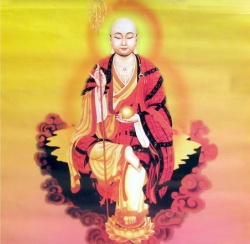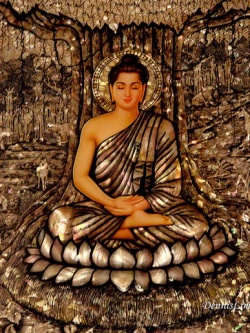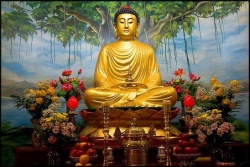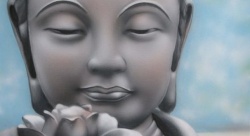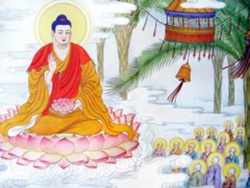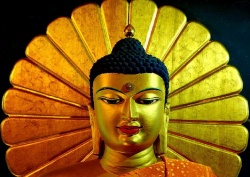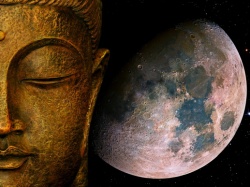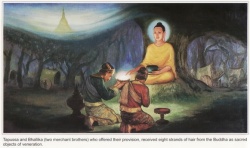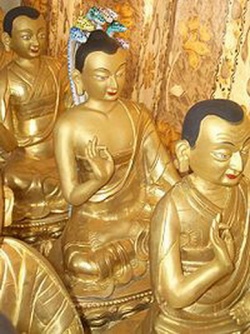Difference between revisions of "The Unification of Wisdom and Compassion"
m (Text replace - "foremost" to "foremost") |
|||
| Line 29: | Line 29: | ||
But then what is the function of this {{Wiki|concept}}? It is as follows: All of our concepts are limiting; they set boundaries. Now we introduce this {{Wiki|concept}} of Blank [[Essence]] which is at the same level as other concepts because they are all only concepts. But this {{Wiki|concept}} tells you, "Let us erase all the boundaries." Since the characteristic of this {{Wiki|concept}} is that it is common to all, let us forget about the boundaries and recognize that all are basically the same. At first, you begin to learn to free your [[mind]] from {{Wiki|conceptual}} limits. In one of the [[Sutras]] it says, "the [[emptiness]] is also [[empty]] (空性亦空, Kong Xing Yi Kong)," which means after you achieve unification of everything and erase all the boundaries, then you should be free from even this {{Wiki|concept}}. Since this is simply an artificial tool to induce you to a certain natural state, after you become free from all the other concepts, you also need to become free from the tool itself. As long as you have a {{Wiki|concept}}, there is bound to be a distinction between [[subject]] and [[object]], and you cannot reach the [[oneness]] of all. So, after you free yourself from {{Wiki|conceptual}} limits through [[Buddhist]] practice, you should also become free from [[Buddhist]] concepts. That is how free [[Buddhism]] is, and that is the real [[essence]] of [[Buddha's]] teachings. It gives you all the teachings, but in the end there is [[nothing]] to hold you down. So I hope that by translating into "Blank [[Essence]]" and providing such an explanation you will understand how useful it is. It should now be easier for you to understand the rest of this [[Sutra]]. | But then what is the function of this {{Wiki|concept}}? It is as follows: All of our concepts are limiting; they set boundaries. Now we introduce this {{Wiki|concept}} of Blank [[Essence]] which is at the same level as other concepts because they are all only concepts. But this {{Wiki|concept}} tells you, "Let us erase all the boundaries." Since the characteristic of this {{Wiki|concept}} is that it is common to all, let us forget about the boundaries and recognize that all are basically the same. At first, you begin to learn to free your [[mind]] from {{Wiki|conceptual}} limits. In one of the [[Sutras]] it says, "the [[emptiness]] is also [[empty]] (空性亦空, Kong Xing Yi Kong)," which means after you achieve unification of everything and erase all the boundaries, then you should be free from even this {{Wiki|concept}}. Since this is simply an artificial tool to induce you to a certain natural state, after you become free from all the other concepts, you also need to become free from the tool itself. As long as you have a {{Wiki|concept}}, there is bound to be a distinction between [[subject]] and [[object]], and you cannot reach the [[oneness]] of all. So, after you free yourself from {{Wiki|conceptual}} limits through [[Buddhist]] practice, you should also become free from [[Buddhist]] concepts. That is how free [[Buddhism]] is, and that is the real [[essence]] of [[Buddha's]] teachings. It gives you all the teachings, but in the end there is [[nothing]] to hold you down. So I hope that by translating into "Blank [[Essence]]" and providing such an explanation you will understand how useful it is. It should now be easier for you to understand the rest of this [[Sutra]]. | ||
| − | The [[Sutra]] continues with "[[Sariputra]]," [[Sariputra]] is one of the ten | + | The [[Sutra]] continues with "[[Sariputra]]," [[Sariputra]] is one of the ten foremost [[disciples]] of [[Sakyamuni Buddha]], and he is famous for his [[wisdom]]. It is said that among all [[Buddha's]] [[disciples]], Sariputra's [[wisdom]] is the most profound; therefore he is capable of receiving this [[teaching]] on the [[essence]] of [[Wisdom]]. Not everyone is capable of understanding such subtle [[teaching]], so when it comes to [[teaching]] the [[essence]], it is given only to the student who is ready for it. That is why [[Avalokitesvara]] gives this [[teaching]] to [[Sariputra]]. He called his name to get his [[attention]] and said, "[[Sariputra]], [[phenomena]] are inseparable from Blank [[Essence]], and Blank [[Essence]] is inseparable from [[phenomena]]." That is exactly what we have just said. It is everywhere, but it is nowhere to be found. There is no such independent thing as a Blank [[Essence]], therefore it is inseparable from [[phenomena]]. Furthermore, he said, "[[Phenomena]] are identical to Blank [[Essence]], and Blank [[Essence]] is identical to [[phenomena]]." There is a very subtle point here. Earlier we had said [[phenomena]] are inseparable from Blank [[Essence]] and vice versa, and now we say one is identical to the other and vice versa. It sounds redundant. Is [[Avalokitesvara]] just repeating Himself to emphasize His point? I don't think so. |
Years ago the [[Buddhists]] developed their [[logic]]. It was not as detailed and as well-developed as the modern {{Wiki|mathematical}} [[logic]]; however they had excellent [[philosophical]] studies and works. They were careful and had [[logic]] in [[mind]] when they composed the [[Sutra]]. First they said, "A is not different from B" the word "inseparable" in the [[sense]] of not different. (Literally I could have used not different to translate, nevertheless, inseparable conveys more the appropriate [[sense]] in the context.) Then why do they have to say that they are identical? If I have two copies of the same book, one copy is no different from the other, but they are not identical. We know that they are two copies, but we cannot distinguish one from the other. When you say that they are not different, you still need to say that they are identical to make sure that it is not two copies of the same book, but that there is only one copy there. Well, if that is the case, why not simply say they are identical and eliminate the first part, i.e., "one is not different from the other, and vice versa"? But then you have to examine it more closely to recognize the finer subtleties. | Years ago the [[Buddhists]] developed their [[logic]]. It was not as detailed and as well-developed as the modern {{Wiki|mathematical}} [[logic]]; however they had excellent [[philosophical]] studies and works. They were careful and had [[logic]] in [[mind]] when they composed the [[Sutra]]. First they said, "A is not different from B" the word "inseparable" in the [[sense]] of not different. (Literally I could have used not different to translate, nevertheless, inseparable conveys more the appropriate [[sense]] in the context.) Then why do they have to say that they are identical? If I have two copies of the same book, one copy is no different from the other, but they are not identical. We know that they are two copies, but we cannot distinguish one from the other. When you say that they are not different, you still need to say that they are identical to make sure that it is not two copies of the same book, but that there is only one copy there. Well, if that is the case, why not simply say they are identical and eliminate the first part, i.e., "one is not different from the other, and vice versa"? But then you have to examine it more closely to recognize the finer subtleties. | ||
Revision as of 08:17, 7 September 2013
This evening I would like to talk about "The Unification of Wisdom and Compassion." When Buddha realized Buddhahood he attained the original state of the oneness of everything without limit. That state is beyond any description; however, in order to help sentient beings who were not aware of this reality, he used language that they could understand in order to guide them toward that experience. In so doing there is a limitation, because languages are built upon concepts, and concepts automatically set limits. The concepts are limited by nature, so how are we going to accomplish the task of using limited tools to describe a limitless state? Because of that, in describing Buddhahood, quite often in the Sutras you will find that they will have to say, "Buddha is complete in two ways."
Because of the limits of language we can speak only about certain aspects at one time. The rational aspect of Buddhahood is called "Wisdom," and the emotional aspect or the aspect of the will is called "Compassion." So we always say, "Buddha is complete in Wisdom and Compassion." However, we should realize that in Buddha himself there is no such distinction between Wisdom and Compassion. Whatever he does, whatever he says, whatever he thinks, is the totality and the unification of Wisdom and Compassion. But for us to understand it, we must describe it from different angles, therefore we say it has two sides.
So in our practice it is important to know that although our goal seems to be Wisdom and Compassion, ultimately they should be unified to the extent that the practitioner makes no distinction between Wisdom and Compassion. Also, precisely because of this, for our theory to be correct as to what Buddhahood is and how to achieve the unification of Compassion and Wisdom, it should be such that you can start from the practice of Wisdom and finally reach Compassion, and also from the practice of Compassion you should be able to reach Wisdom.
Wisdom and Compassion are abstract ideals. What are the principles that we can use in order to practice Wisdom and Compassion? In order to explain this, I will give an explanation of two articles. Both are included in the beginning of this book. One is the famous Heart Sutra which I have translated and published in a booklet entitled, "Pureland Daily Practice." The Heart Sutra emphasizes the Wisdom aspect of Buddhism; it contains the essence of Buddhist Wisdom. But what about the essence of Buddhist Compassion? Parallel to the Heart Sutra, I have written an article entitled "The Heart of Sublimation through Limitless-Oneness Compassion Sastra." Because it has been written by me, not something given by Buddha, it cannot be called a "Sutra"; it is called a "Sastra." In Buddhism, Buddhists are allowed to offer their theses as long as they are consistent with the Sutras, and those are called "Sastras."
I wrote this Sastra in Chinese, and you can find it in my book called, "無限的智悲, Wu Xian De Zhi Bei." It is the second article in that book called, "大悲波羅蜜多心要, Da Bei Bo Luo Mi Duo Xin Yao." Following that is the transcript of my expounding talk, given in Taipei, called, "心經與大悲心要之會通, Xin Jing Yu Da Bei Xin Yao Zhi Hui Tong" ("The Unification of the Heart Sutra and the Compassion Sastra.") So, I am telling the Chinese members of the audience about the sources in case they are interested in reading more about this. For the English readers, in addition to the Heart Sutra in the Pureland Daily Practice, I have provided the English version of my Sastra as the appendix to my book entitled "A Blessed Pilgrimage." All of these books are available as Dharma gifts.
So let us start with the famous Heart Sutra. Since we have only a very short time, I am not going to give a detailed explanation, but I will try to emphasize the essentials of this Sutra. Then I will compare it with my Sastra to help you learn how to practice them in a unified way. I have given a succinct explanation on the concept of Blank Essence in the preface to the Pureland Daily Practice. Now I will go directly to my explanation of the Heart Sutra and explain the concept of Blank Essence along the way in details.
Usually the title of the Heart Sutra is translated as "the Heart of Wisdom Paramita Sutra." "Paramita" means reaching the other shore, meaning that from this shore of suffering we reach the other shore which is the state of liberation and peace of Buddhahood. It is sometimes translated into English as "perfection." You may wonder why I use "sublimation" instead of "perfection." The reason is because when you say something is perfect, you mean it is complete. Although it may be complete, it is still at the original level. But in Buddhism, the Wisdom is to transform you in such a way that you transcend your ordinary level of being human. It is a kind of sublimation, a refinement, so I translated it as "sublimation" to emphasize this aspect. It is not the same level as becoming a complete man. You reach a higher level and you become a Buddha.
I translated it from the Chinese version which was done by a great monk, the Reverend Xuan-Zang of Tang Dynasty. It begins with, "Whenever Bodhisattva Avalokitesvara," this Bodhisattva represents the Compassion of all Buddhas. Here, there is a hidden teaching which is extraordinary. In Buddhism, it is said that the essence of all Buddhas' Wisdom is embodied in the Bodhisattva Manjusri. But here, the Sutra is about the essence of Wisdom, and yet the teaching is not coming from Manjusri; instead, it is from Avalokitesvara who is the embodiment of the essence of Compassion. You may ask why. It is because the Sutra implies that Wisdom and Compassion are fundamentally inseparable and that profound Wisdom is contained in great Compassion. This is a very subtle point.
So, when He "practices deeply Sublimation through Transcendent Wisdom, He intuitively perceives that the five aggregates are of Blank Essence, thus transcending all suffering and difficulties." What is meant by "Sublimation through Transcendent Wisdom"? Namely, Avalokitesvara goes into meditation to reach the oneness of all. That is the sublimation. Ordinarily we are confined by concepts. We think, "body is body, mind is mind, I am I, and you are you; they all have boundaries." Nevertheless, when Avalokitesvara goes into meditation to go beyond all these boundaries, all become one. When He is able to reach that experience, He will transcend all suffering and difficulties. You may ask why. Because all our experiences are transient. For example, when we are in pain, at first we are very aware of it, but with time it seems to disappear. But when you add the psychological complaining "Oh! I'm in such terrible pain." That is what really causes the trouble. Because Avalokitesvara's mind is so large, as large as the whole universe, the severe pain, by comparison with the whole universe, becomes insignificant. He would not allow all these thoughts to bother him: "Oh! This is painful! I'm unlucky! Why is God so unfair to me!" All these kinds of complaints will increase the pain. Just take it as it is, and let it be part of the universe. That is the best way to take it; since it is transient, it will just disappear by itself. That is the way to truly free yourself from all suffering.
What I have just talked about is not just theoretical. It can be realized through practice, however it is not magic. You need to train yourself in order to reach that state of mind. It becomes a problem only when we blow it out of proportion. Release those thoughts, and life will not be so difficult. Many of our problems in life are created by our conceptions. The Heart Sutra continues with "He intuitively perceives" which means it is not the result of rational thinking. Whenever you are still using ideas to explain or understand phenomena, you will not be able to have the freedom of becoming one with the whole universe. Therefore you have to go beyond. You have to go beyond through your meditation so that your thinking can stop. In meditation the first step is the concentration practice. We want to be able to concentrate on one point, for example, a dot. When you are able to concentrate on that dot, the ideal state is such that your thoughts have stopped. No other thoughts will distract you from that mindfulness.
In the Heart Sutra it says: "He intuitively perceives that the five aggregates are of Blank Essence," What are the five aggregates? In Buddhism, we classify our experiences into the following five categories: phenomena, feeling, conceptualization, motivation and consciousness. All the things that we experience are of Blank Essence. What is meant by "Blank Essence"? The Chinese character is空性, Kong Xing; 空, Kong, literally translated into English means empty, but in Buddhism, when we talk about emptiness it does not mean nothingness. The word itself, unless you understand it well, usually means nothingness. So it may be misleading if I use emptiness. Nevertheless, there is a proper way to explain it, but it is very philosophical—the philosophical meaning is empty of inherent existence. To understand why they use this kind of terminology would require a long explanation of how they arrived at this concept. Let us not get into a philosophical analysis in this talk; we want to be able to understand it as ordinary people, not as philosophers.
This concept in Buddhism is usually called "emptiness" (空性, Kong Xing); but I have translated it as Blank Essence. "性, Xing" means essence, but what kind of essence is this? It is the essence of all; all things share this common essence. But what is the property of this common essence? The property is that of being blank. I use the term "blank" to help you understand it. You may ask why. Since it is common to all, it cannot have any particular property of its own. For example, if it is white, and then combined with red, it will become pink. Therefore, this essence cannot have any property of its own in order for it to be so universal.
So, in order to introduce this concept, I use the word "blank" because it is easy to understand. We have a blank board here, but it is not nothing, it is just blank. You can draw whatever you like on it. Another way to understand this concept is to look at it as you would a blank TV screen. Before you turn on your TV, the screen is blank, but once you turn it on, all kinds of things appear and come and go, just like our experiences. This example should make it a little easier to understand the concept of this essence, without mistakenly thinking of it as nothingness. No, it is not nothingness. It is common to all and yet has no particular property of its own; it is everywhere, and yet nowhere to be found. Since it has no particular property, you cannot pinpoint it and you cannot picture it. But why do we need to use such a concept that has no reference to anything? Isn't it just a thought? Yes, it is just a concept. The whole teaching is just a system of concepts trying to bring you from your ordinary experiences to the experience of oneness with everything without limits.
But then what is the function of this concept? It is as follows: All of our concepts are limiting; they set boundaries. Now we introduce this concept of Blank Essence which is at the same level as other concepts because they are all only concepts. But this concept tells you, "Let us erase all the boundaries." Since the characteristic of this concept is that it is common to all, let us forget about the boundaries and recognize that all are basically the same. At first, you begin to learn to free your mind from conceptual limits. In one of the Sutras it says, "the emptiness is also empty (空性亦空, Kong Xing Yi Kong)," which means after you achieve unification of everything and erase all the boundaries, then you should be free from even this concept. Since this is simply an artificial tool to induce you to a certain natural state, after you become free from all the other concepts, you also need to become free from the tool itself. As long as you have a concept, there is bound to be a distinction between subject and object, and you cannot reach the oneness of all. So, after you free yourself from conceptual limits through Buddhist practice, you should also become free from Buddhist concepts. That is how free Buddhism is, and that is the real essence of Buddha's teachings. It gives you all the teachings, but in the end there is nothing to hold you down. So I hope that by translating into "Blank Essence" and providing such an explanation you will understand how useful it is. It should now be easier for you to understand the rest of this Sutra.
The Sutra continues with "Sariputra," Sariputra is one of the ten foremost disciples of Sakyamuni Buddha, and he is famous for his wisdom. It is said that among all Buddha's disciples, Sariputra's wisdom is the most profound; therefore he is capable of receiving this teaching on the essence of Wisdom. Not everyone is capable of understanding such subtle teaching, so when it comes to teaching the essence, it is given only to the student who is ready for it. That is why Avalokitesvara gives this teaching to Sariputra. He called his name to get his attention and said, "Sariputra, phenomena are inseparable from Blank Essence, and Blank Essence is inseparable from phenomena." That is exactly what we have just said. It is everywhere, but it is nowhere to be found. There is no such independent thing as a Blank Essence, therefore it is inseparable from phenomena. Furthermore, he said, "Phenomena are identical to Blank Essence, and Blank Essence is identical to phenomena." There is a very subtle point here. Earlier we had said phenomena are inseparable from Blank Essence and vice versa, and now we say one is identical to the other and vice versa. It sounds redundant. Is Avalokitesvara just repeating Himself to emphasize His point? I don't think so.
Years ago the Buddhists developed their logic. It was not as detailed and as well-developed as the modern mathematical logic; however they had excellent philosophical studies and works. They were careful and had logic in mind when they composed the Sutra. First they said, "A is not different from B" the word "inseparable" in the sense of not different. (Literally I could have used not different to translate, nevertheless, inseparable conveys more the appropriate sense in the context.) Then why do they have to say that they are identical? If I have two copies of the same book, one copy is no different from the other, but they are not identical. We know that they are two copies, but we cannot distinguish one from the other. When you say that they are not different, you still need to say that they are identical to make sure that it is not two copies of the same book, but that there is only one copy there. Well, if that is the case, why not simply say they are identical and eliminate the first part, i.e., "one is not different from the other, and vice versa"? But then you have to examine it more closely to recognize the finer subtleties.
The Sutra says that Blank Essence and phenomena are identical. But what are they? They are two concepts. When we say "phenomena" we talk about all our experiences, but this phenomena is just an abstract concept used to talk about all particular experiences. It is a concept, and Blank Essence is another concept. They are two concepts and they are defined differently. But now we say that the two concepts are identical. What does this mean? The only way that you can say that two concepts, although defined differently, are identical is to say that they are referring to the same thing; in other words, "Phenomena" refers to all of our experiences, and "Blank Essence" also refers to all of our experiences. The classes of particular ones that they refer to are identical. That is the only way for us to understand that these two different concepts are identical. However, that is not what is meant, because there is no need to say that the universe is identical to the universe. Since the Sutra wants to bring out the even subtler part, it needs to say that they are not different, they are inseparable. This is very strange and logically a contradiction. They are two concepts, defined differently, yet the Sutra says that they are inseparable, not different. How could that be? Here lies the key point. The essence of Buddhism can be explained only through the use of contradiction because if everything is understood through definitions, then the distinction of subject and object will always be there, leaving us with no way out. The only way out of this dilemma is to recognize the basic fact that language is just a tool. Blank Essence is a concept which is just an artificial device. When we say that they are inseparable, that they are not different, we are emphasizing that they are simply our mental constructions and we should not be fooled into thinking that concepts have an independent existence. So Blank Essence helps us to be free from concepts. Eventually we also have to go on without this device.
I added the following remarks on March 31, 1992:
There are two additional subtleties in the composition of the Heart Sutra that I would like to point out. Instead of simply stating that phenomena are inseparable from Blank Essence, it says, "Phenomena are inseparable from Blank Essence, and Blank Essence is inseparable from Phenomena;" Similarly presented are the statements on the identification of phenomena and Blank Essence.
My explanation is that in both cases the underlying logic is to avoid the misunderstanding of a partial inclusion relationship between the two classes referred to by these two concepts, and to ensure the correct understanding of a complete identification of the two classes. Consider the following examples: "Human beings are inseparable from mammals," and "Human beings are mammals," are both true, but the reverse statements are not true.
I added the following remarks on July 12, 1994:
The Heart Sutra states first, "Phenomena are inseparable from Blank Essence, and Blank Essence is inseparable from phenomena;" and then, "Phenomena are identical to Blank Essence, and Blank Essence is identical to phenomena." The order of this presentation, in the light of my explanation given above, makes sure that the subtle identification of phenomena and Blank Essence is conveyed, without bringing forth the underlying logical paradox.
In contrast, consider the case when the order of presentation of these two pairs of sentences were reversed. Then the logical difficulty becomes protrusive and bewilders novices when they reflecting as above, I cannot but admire the beauty of the underlying structure in this part of the Sutra.
Following this, the Sutra talks about feelings, conceptualization, motivation, and consciousness. These are the traditional Buddhist classifications of our experiences. In all these classifications, each class has the same relationship with Blank Essence as explained above in the case of phenomena. The function of the concept of Blank Essence is to erase the limits set by all of them.
The Sutra continues: "Sariputra, the characteristics of Blank Essence of all these things are: neither born nor deceased," Originally we have the polarized pair of concepts of born and deceased, but this Blank Essence is not a polarized concept. If it is polarized, then it is still within the subject/object distinction. "Neither born nor deceased" is about existence; "neither dirty nor clean" is about quality; and "neither increasing nor decreasing" is about quantity. The concept of Blank Essence transcends all such distinctions. It is not limited by existence or non-existence, quality or quantity.
The Sutra continues with: "Therefore in Blank Essence there are no phenomena, no feeling," The Sutra seems to be denying the existence of all things, but it is not denying the occurrences of our experiences. It is just telling us to be free from all these categorizations. It does not mean that we would become incapable of differentiating our experiences, rather it teaches that only after we have learned to become free from conceptualization, can we experience things as they are. Basically it is saying that the function of Blank Essence is to remove all boundaries set by the concepts of phenomena, feeling, conceptualization, motivation and consciousness. We don't even pay attention to the distinction of eye, ear, nose, tongue, body and mind. The Sutra continues with "No color, sound, odor, flavor, touch and impression; no eye-species up to and including no perceptual-consciousness-species." Up to this point the Sutra is talking about various Buddhist categorizations of our experiences. Now we are told to forget about all these classifications.
Then we are also told to forget about the basic classifications that constitute the Buddhist teachings. Here the Sutra begins to talk about the Twelve Dependent-Origination Links. It states, "No Ignorance and no elimination of Ignorance, up to and including no senility and death and no elimination of senility and death;" These are the basic teachings within Buddhism, however, the Sutra says that Blank Essence goes even beyond the teachings. The teaching tells us: If the Twelve Dependent-Origination Links go one way, then it is Samsara; if it goes another way, then it is Nirvana. Now we should forget about all of that; everything should be erased. Furthermore, the Sutra even says that it is not limited by the Four Noble Truths, "No suffering, its causes, its transcendence, the path toward its transcendence." And finally it even says that there is no fruit of enlightenment; "No Wisdom and no attainment." Previously we wanted to achieve the Wisdom of Buddha and attain Buddhahood. But now it says "No Wisdom and no attainment." Since these are still concepts, now in view of Blank Essence, let us erase them, let us return to the original blank.
The Sutra continues with: "Since there is no attainment, by sublimation through Transcendent Wisdom, a Bodhisattva's mind has no attachment." This is most important. If we are obsessed with the question of whether or not we have achieved Buddhahood, then we can never be truly free, even though Buddhahood means complete liberation. For example, you cannot really enjoy your marriage if you always have an ideal wife or ideal husband in your mind. Then you will always criticize the one you married by making the comparison with the ideal one who has never existed and will never exist. If you really understand the teaching of Buddhism, you will realize that the teachings are not only for attaining Buddhahood, but are also applicable to our daily lives. According to the teaching, from the Wisdom aspect, the distinctions are to be forgotten. Then what happens? It follows that we need to learn no attachment. This is the key to practicing Wisdom. In my previous talks on "Introduction to Buddhist Meditation" (available now as a book titled, "A Golden Ring") I said, in order to achieve this Limitless-Oneness, the principle of the inactive aspect, both for our practice and for our daily lives, is no attachment, i.e., to give up our prejudices and our attachments.
The Sutra continues with: "Since there is no attachment, there is no fear." Actually, in the Chinese translation of the Reverend Xuan-Zang, if I had translated it literally, it would read, "a Bodhisattva's mind has no hindrance. Since there is no hindrance, there is no fear." But according to his version we don't know what the hindrance is. Therefore, I pointed out that the hindrance of a Bodhisattva is nothing external but rather his own attachment. When you are free from your attachments, then there is no fear. When you have some attachments, then you start worrying about what is good or bad, or better or worse. If it is good, can I keep it from deteriorating? There will be no end to your worries. Only when you are free from attachments, can you have no fear; you simply accept things as they are. When your mind is as large as the entire universe, there is nothing that you cannot accept. Whatever happens will not bother a mind so great.
Hence, the Sutra continues: "There is freedom from perversive delusions," which means we are free from all attachments and the limited views that we previously had, "and Nirvana is realized." "Buddhas of the past, present and future attain the Unsurpassable Right and Full Enlightenment by the sublimation through Transcendent Wisdom." That means all Buddhas of past, present and future attain complete freedom through the realization of this state of Limitless-Oneness.
"Therefore sublimation through Transcendent Wisdom is known to be the great wondrous mantra," since it has such a magical effect, it is comparable to a mantra. Once you realize the Limitless-Oneness, you can achieve great results. Therefore, it is called "the great wondrous mantra." "The great open mantra," and in Chinese, it literally means the great brightness mantra. But I used "open" to emphasize that brightness is attained through the active principle of opening up; that is why I translated it as "the great open mantra." The Sutra concludes with: "the unsurpassable mantra, the no-equal-rank mantra, capable of eliminating all suffering, truthful and without deceit. Hence, the mantra of Sublimation through Transcendent Wisdom is to be proclaimed.' So He utters the mantra: gate gate paragate parasamgate bodhi svaha." Why does the Sutra give us a mantra at the end? Although the teaching is simple, it is contrary to the actual practices of our daily lives. Life in our society is based upon concepts, customs and cultures. What can we do to unlearn them? We need a practice, and the practice implicitly recommended here is the chanting of this mantra.
An essential way to reach Wisdom through practice is to chant a mantra or the name of a Buddha, for example, "Amitabha"; it does not matter which one you choose. After you have chosen one, just stay with it and you will grow and gradually have the strength to free yourself from many layers of conceptual bondage. Do not be concerned that it will bring disorder into your life. On the contrary, the fewer mental limitations you have, the more you will become one with and compassionate to others. Do not worry that the result will be anarchy. No! The result will be a natural feeling of love and fellowship for all beings. Then you will only do good deeds.
Usually we do not need to know the meaning of a mantra. Nevertheless, the meaning of this mantra is: Reach, reach, reach the other shore, reach beyond the other shore, and reach Enlightenment soon! It is a blessing from the Great Compassion of Avalokitesvara to whomever receives this teaching. He is giving you a blessing, wishing that you will soon achieve this liberation.
I have given you a brief explanation of the Heart Sutra. It is a teaching from the Wisdom aspect, but we also want to learn about the other aspect which is the Great Compassion. When you realize the Oneness of all things without limits, then stemming from that Oneness, the Great Compassion comes naturally and it knows no boundaries. With this Great Compassion there is no distinction made between species, friends, relatives, etc.; it is a natural outflow of loving-kindness from your heart.
Let us examine my work, "The Heart of Sublimation through Limitless-Oneness Compassion Sastra." I gave it this title because this Compassion is the result of Limitless-Oneness. The best way to learn how to achieve the Great Compassion is to look at the result of Buddhahood which is the Limitless-Oneness. It is obvious that the emotional aspect of the Limitless-Oneness is limitless Compassion.
The Heart Sutra begins with: "Whenever Bodhisattva Avalokitesvara"; parallel to that, this Sastra begins with: "Wherever Bodhisattva Manjusri." Although using whenever and wherever are essentially the same; however, the Heart Sutra is talking about the time aspect, so in contrast I am bringing out the other coordinate which is the space aspect. The Sastra reads, "Wherever Bodhisattva Manjusri practices Sublimation through Limitless-Oneness Compassion effortlessly." In the Heart Sutra the teaching on Wisdom is given by the Bodhisattva of Compassion; hence, in my Sastra the teaching on Compassion is given by the Bodhisattva of Wisdom. When Avalokitesvara was giving the teaching on Wisdom, He went into the Meditation of Transcendent Wisdom, which is the static state. Now I am bringing out the dynamic aspect, because out of Compassion you have to act. When you see someone suffering, you must help. So Compassion brings out the dynamic state, the salvation activities of Buddha. So, I am saying that when Manjusri practices, His practices are the salvation activities. Why does He practice effortlessly? It does not mean that He does not work, it just means that it is a natural result of such Compassion. In His Compassion everything He does is natural, just as what a mother is giving to her children. His activities are without selfish motives, never being compelled by anyone. He acts naturally, effortlessly and spontaneously out of Great Compassion. Besides, the Great Compassion is not just a transient feeling; it has matured into devoted activities. Therefore, He practices compassionate activities.
The Sastra continues with: "He intuitively understands that the five aggregates are of one essence," because this insight is not merely a conceptual understanding. Anyone who practices Compassionate activities will gradually see many kinds of people and learn that all of them are capable of both happiness and sorrow. All want happiness and all worry about unpleasant things happening to them; all have attachments. You see the sameness in them and yourself. Through service you will learn the Oneness of all. The reason that we are prejudiced is because we are limited to certain environments and certain views. If we never encounter varieties of situations, then we will not broaden our minds. We are limited by what we are accustomed to.
Once you begin to serve other people in the Buddhist way, when the time is right, you will tell them about the benefits of certain Dharma practices, such as the chanting of "Amitabha," without expecting any rewards. You simply keep doing this kind of Dharma services. Gradually, you will learn that we are all the same, and we can all benefit from doing Buddhist practices. That is how Manjusri became able to intuitively understand and realize that we are all the same. "thus enduring all suffering and difficulties." In the Wisdom aspect, His mind becomes so broad that He transcends suffering; and through the practice of Buddhist services His Compassion grows. The more He serves, the more He is able to endure all the difficulties and suffering that others cannot bear. Others may complain when someone hurts or offends them, but because Manjusri has helped many people and has been through many situations, He understands that someone did something out of ignorance, or suffers because of limited views, or does not know how to be nice to others, or does not understand others' intentions. He understands why others act in such ways. Gradually He will understand that, as long as He keeps His intentions pure and does pure services, eventually all misunderstandings will be resolved. Then He can endure everything through practicing Compassion.
Now, Manjusri begins to give the teachings, and the disciple he chose is called "Sudhana." Sudhana (善財童子, Shan Cai Tong Zi) is the main disciple of Manjusri in the Avatamsaka Sutra (華嚴經, Hua Yan Jing). In this Sutra, Sudhana, under the guidance of Manjusri, went through fifty-three teachers and many kinds of training; he learned many things. I have chosen Sudhana to be the disciple who is capable of receiving this teaching on the essence of Compassion because he has gone through a lot and has seen many different situations. What I am trying to say is that when you start to serve others, you have many new experiences. In your services you need to maintain the humble attitude of a disciple so that you will respect everyone as if they were your teachers. If you learn from all beings just as Sudhana had done in the Sutra, then you will gain the essence of Compassion.
So he says, "Sudhana! Phenomena are inseparable from essence, and essence is inseparable from phenomena." This part, in English, I have to state like this because there is no other proper way to do it. In Chinese, what I am saying is, "phenomena are inseparable from this Oneness." Everything is within this Oneness, the concept of Oneness. Then, again, it is similar to the Heart Sutra that phenomena are identical to essence and so forth. As to feeling, conceptualization, motivation and consciousness, they are all the same as in the Heart Sutra. Then, "Sudhana! The Limitless-Oneness of all these things transcends existence and non-existence, attraction and repulsion, plurality and singularity. Therefore the Limitless-Oneness contains phenomena," Now comes the beautiful part.
In the Wisdom aspect, they say, let us forget about the boundaries. Erase them; there is no this, no that; everything is erased. But that is contradictory to our daily lives. In our daily lives, everything is there. But now from this Compassion aspect, it says, all is one. So, it does not matter that there are many things. If I exclude anyone from this Compassion, then this is not the Limitless-Oneness Compassion. This Compassion does not care that there are differences, or varieties, or this or that; all are embraced. This makes it easier for us to handle our lives. How do we achieve greatness? All are embraced; accept all!
Of course, there is contradiction in this approach, but let us stay at the abstract ideal level for now. At the abstract level it sounds simple—all are embraced. Of course, it is very difficult to do. Nevertheless, if your mind is really as large as the universe, then what is there that you cannot accept, that you cannot embrace? Life-and-death is just a part of the universe. Our life-and-death is a very tiny thing in the whole universe, in the history of the universe. So, it is insignificant in that sense; we can even accept our own life-and-death with ease. Since this Sastra is parallel to the Heart Sutra, here it reads, "contains phenomena, contains feeling," i.e., everything.
Finally, in the Heart Sutra, it says, "No Wisdom," Parallel to that, I said this Limitless-Oneness "transcends Loving-kindness." In the Heart Sutra it mentions Wisdom, so in this Sastra I mention Compassion, and Compassion here is paraphrased as Loving-kindness. The point here is that the Limitless-Oneness not only contains Loving-kindness but transcends it. You may ask why. When your mind is so open, you are not limited by anything. If you think that you are doing this out of Compassion, then you are still limited by the concept of Compassion. The Great Compassion transcends even that. This means in practice you become so pure in doing good deeds that you do not know that you are good. It is just natural to you. A child sometimes just naturally offers something to you. He does not think that he is doing a good deed. No! He just likes you, so he offers you something. It is natural, pure goodness without the reflective awareness of being good.
Furthermore, it "transcends loss." In the Heart Sutra, it says, "no attainment"; here in my Sastra it says, "no loss." You may ask why. Everything is contained here. When money goes to others' pockets, if I am identifying with the universe, then there is no loss. So, when your car is stolen, well, there is no loss in that sense. It transcends the ordinary outlook on life. When your mind is open, this is possible. For example, if you are very, very rich, losing a car does not matter. Just think like that and gradually it will be possible to achieve such broadness of mind. "Since there is transcendence of loss, by Sublimation through Limitless-Oneness Compassion, a Bodhisattva's mind is free from attachment." In the Wisdom aspect, we say there is no ttainment. Since there is no attainment, you have nothing to worry about, therefore you are free from attachment. Now, we are talking about the Compassion aspect. In the Wisdom aspect it talked about attainment; hence, in the Compassion aspect, for contrast, I talk about loss. If there is no loss, then again, you have nothing to worry about.
I am showing the essence of Wisdom and Compassion by parallel comparisons. Using language always involves a polarization, and you are limited to only one side at a time. He is practicing Wisdom in that way, and I am practicing Compassion in this way. However, the point is not to antagonize, but rather to unite. Buddhism is actually free from any polarization. We should know both sides, know how to unify them, and thus be free from one-sided limitations.
"Since there is no attachment, there is no criticism." When you have a panoramic view, you can see that each person is acting from a one-sided view. They are attached to their views and acting in their particular ways, therefore they have conflicts. People fight because of their ignorance and attachment. But once you have awakened to this Oneness, then you are beyond conflicts. When you are criticizing others, you are judging from a certain point of view; from that point of view, people are right or wrong. Whenever you are involved in criticism, you are standing on some ground. But this Oneness transcends all grounds, consequently all criticisms just disappear. You do not have to waste your life fighting or criticizing others, you will live in harmony with all. You will see the reason for everyone's actions; all actions are based on certain views or attachments, and are limited by such views or attachments.
If all of us are free from narrow-mindedness, then we will not fight and we will naturally do only good deeds for others. The basic difficulty in obtaining peace is ideological. Instead of the Russians and the Americans trying to live together, they were blocked by their ideologies; previously there was no free communication; anyone who came from the other side was considered a spy. No matter how good they were, they were already labeled as spies; consequently they never found out what they all had in common.
"There is freedom from prejudiced discriminations, and Nirvana is realized." In our lives, we are limited by our cultures; we have many prejudices. We mistreat other people and we discriminate against others according to our prejudices. But when you are free from prejudiced discriminations, you will not mistreat others. And then "Nirvana is realized." "Buddhas of the past, present, and future attain the Unsurpassable Right and Full Enlightenment by Sublimation through Limitless-Oneness Compassion. Therefore Sublimation through Limitless-Oneness Compassion is known to be the great mind mantra," "great mind" indicates the mind that is limitless, "the great loving-kindness mantra, the indiscrimination mantra, the all encompassing mantra." It is great loving-kindness because it is limitless; it is beyond the concept of loving-kindness.
In the Heart Sutra, the approach is to eliminate suffering through transcendence; but here in my Sastra it is "capable of enduring all suffering, absolute and joyous." That means to obtain transcendence through endurance. When you practice accepting things and enduring hardships, at the beginning, of course, it is difficult. You will have complaints and you will have to make an effort to endure. You will still think: "Oh! I am suffering without complaining." Later when you have practiced it to the extent that your endurance is absolute you are free from complaints and you simply take it as it is, then it becomes joyful. What to others may seem like intolerable suffering and endurance, to one who has practiced tolerance to the extent that he is really free from being bothered by these things, it may bring joy. Such a person sees that what had previously engulfed him in sorrows has now become nothing to him. He realizes that he is really free from it. How joyful it is when you have that freedom! A child cries over a toy that is broken, but when he grows up he no longer cries for toys. Then he senses the freedom and happiness of growing up. You might understand my point through reflecting on this parable.
"Hence, the mantra of Sublimation through Limitless-Oneness Compassion is to be proclaimed." What is the mantra? In Chinese, it has exactly the same number of characters as that of the Heart Sutra in Chinese. It is:
容忍,容忍,無不容忍,無不樂容忍,菩提娑婆訶!
The meaning is: Tolerance, tolerance, tolerance for all, tolerance with joy, and reach Enlightenment soon! This tolerance is limitless, hence it is for all. If you practice tolerance for all, some day you will experience tolerance with joy. You will enjoy your tolerance and then you can become enlightened very soon. Thus, I have explained the unification of Wisdom and Compassion through the Limitless-Oneness of all.
Question from Mr. David Tseng:
To practice Buddha Dharma, either using the Wisdom approach of emptiness or the Compassion approach of tolerance to transcend life-and-death, that is the supreme goal. But for me, personally, the immediate question is how to apply either one of them to help me through the dentist's drilling of my teeth? That hurts!
Answer from Dr. Lin:
The first thing is to understand that all these teachings come from that final awakening to the truth of the Limitless-Oneness of all. So, first, try to broaden your mind. But this is not something you can achieve at once. Nevertheless, you still can have immediate tolerance for your immediate suffering. What you should do is to rely on your daily practice and your chanting. Both the Sutra and the Sastra, at the end, give you a mantra. You do not need to switch to these mantras; just keep practicing your original one. When you come to a difficult situation, do the chanting because the strength of the habit of chanting will calm you down. That is the most effective way—relying on one basic practice that you always do. Furthermore, this is the one you rely on in case of emergency or crisis. For example, in case of an accident, you do not have time to think of what to do, it has to be a natural response; "Amitabha" simply comes to your mind and it will help you.
Source
By Yutang Lin
yogichen.org
